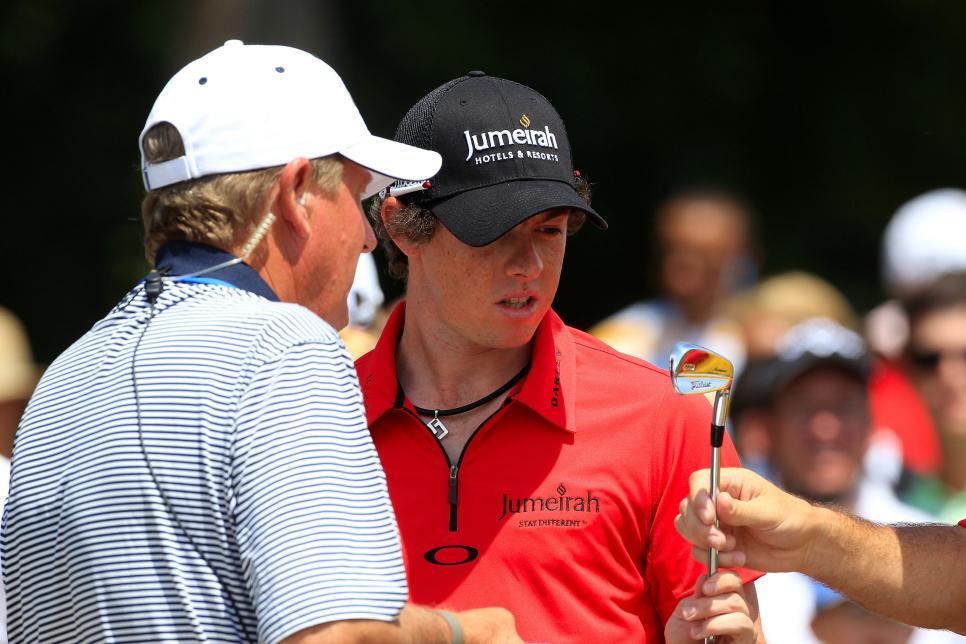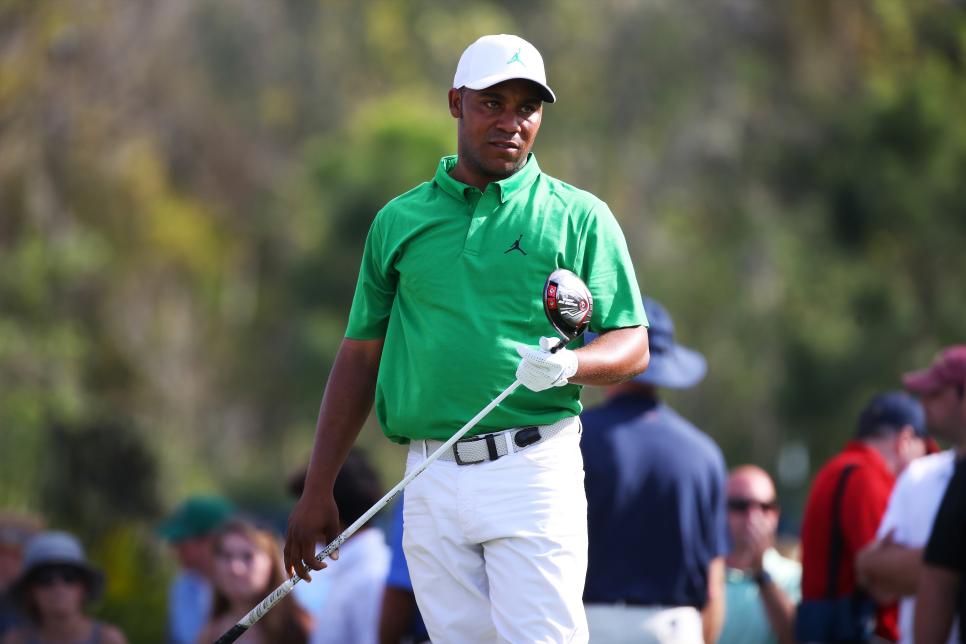MAJOR EQUIPMENT SCENE
PGA Championship 2022: What happens when a club is broken after the equipment vans leave at a major event?

Rory McIlroy damaged his 7-iron during the 2011 PGA Championship at Atlanta Athletic Club. (Getty Images)
Although equipment changes the week of major championships have become less prevalent as players request, receive and test clubs they might use for a specific venue well in advance, company equipment reps still stay busy. This week at the PGA Championship at Southern Hills Country Club, for example, many will see requests from the 20 club professionals in the field. But what is either forgotten (or unknown) by many golf fans is that come Wednesday afternoon, the equipment trucks are already off to the next venue (per PGA Tour regulations), leaving pros potentially in a tight spot if something goes wrong with their clubs once the tournament begins.
Recent history includes several stories of clubs breaking at inopportune times, including at majors. And how players and their respective companies handle it often requires quick thinking, precision timing and nimble problem-solving skills.
The case of Rory McIlroy and his 7-iron at the 2011 PGA Championship is a prime example. McIlroy not only hurt his right arm and wrist when he struck a root on the third hole in the opening round at Atlanta Athletic Club, he also damaged his Titleist MB 7-iron. A call was made to Titleist and the company had a replacement made at its Oceanside, Calif., facility. An employee then took a redeye and flew with the new stick overnight to Atlanta. The club was placed in McIlroy’s locker at 7:25 a.m. Friday just before he went out to warm up for his second round.
It's important to note that at the time of McIlroy’s misfortune, the Rules of Golf allowed for him to replace his club during his round had one been available. Back then, the rule said, in essence, that if a club was damaged during the normal course of play, a player could have it repaired or replace the club with any club, provided it does not come from any other person playing the course and does not unduly delay play.
For those wondering if he could have asked one of his playing partners to use their 7-iron, the answer is no. The only time you can use a club from another player’s bag is in a team competition when the total number of clubs in both bags does not exceed 14. However, the rules would have allowed McIlroy to use a 7-iron from another player in the field, provided they were not on the course at the same time he was.
Today the rules are different, thanks to changes made in 2019. If a player starts with 14 clubs or added clubs up to the limit of 14 and then loses or damages a club during the round (or while play is stopped), the player cannot replace it with another club. But if an “outside influence” or “natural forces” or any other person other than the player and his caddie cause the damage, the player may replace the club and immediately take the damaged club out of play (which would have been the case for McIlroy).
While replacing McIlroy’s club came with some geographic challenges, his replacement 7-iron was pretty standard-issue stuff. A much more intricate equipment save involved Phil Mickelson prior to the 2010 Masters.
Noticing some damage while playing the Shell Houston Open, Mickelson’s Callaway FT Tour TA driver required the golf equipment equivalent of a transplant. Performing the surgery was Dr. Alan Hocknell, Callaway’s senior VP of R&D. Hocknell got the club Sunday night prior to Masters week along with a text message the next morning from Mickelson, who was in Augusta, asking, “How bad is it, Doc? Is she gonna make it?”
Hocknell and his team performed, in their words, “an unprecedented repair,” removing the carbon composite body from the clubface while never taking off the Mitsubishi Fubuki shaft in order to ensure the loft and lie remained untouched (the driver did not have an adjustable hosel).
“We had never done that before, so everyone was a little nervous,” Hocknell said.
The same weights were inserted in the same location in the new shell before it was bonded to the titanium cup face and the same skid plate added to the sole. The driver was on a plane heading to Augusta by 3:30 that afternoon and delivered to Mickelson on the eighth tee during his Tuesday practice round at Augusta National. Lefty went on to rank second in the field in distance with a 297.1-yard driving distance average while winning by three shots over Lee Westwood.
Even the GOAT hasn’t been immune from equipment malfunctions in the majors. On Wednesday of U.S. Open week in 2002, Tiger Woods was on the practice range when the head of his Titleist 970 Series 3-wood was left dangling from a broken shaft after a shot.
Luckily for Woods, or so it seemed, the vans were still on site and the club was brought to True Temper’s van for what seemed like a normal re-shaft job and the club was returned to Woods in less than an hour.
“I got a call from Tiger a little later,” said Steve Mata, Titleist’s director of tour operations at the time. “He had tapped the club on the ground a few times and said he heard some loose epoxy moving around in there. I went to his house and retrieved the club. We checked it and didn’t hear anything but re-shafted it again.”
Mata left the club in Woods’ locker and on Thursday Woods’ caddie Steve Williams got the club and spent several minutes using sandpaper on the grip to get it to Woods’ preferred level of tackiness and the club went in the bag. On the seventh hole (Woods’ 16th of the day), however, the rattle returned, forcing Woods to hit a “soft-armed” driver instead of the club. Afterward it was discovered that a loose piece of foam, not epoxy was the culprit. Having left Bethpage, Mata had two backups built and delivered to Woods on Friday morning.

Harold Varner III at the 2019 Players Championship (Getty Images)
The Players Championship isn’t quite a major, but it’s close enough for this discussion, and Harold Varner’s 2019 tournament shows replacing a broken club needs to be carefully done in order not to run afoul of the rules.
Prior to his opening round at TPC Sawgrass, Varner cracked his driver on the practice tee. As such, he started his round with 13 clubs and intended to have another driver brought out to him—allowable under the rules. But Varner wanted to use the same shaft that was in his gamer. That was also allowable under the rules as long as the assembly took place off the course. That’s where things went wrong. After leaving the shaft back at the tee, hoping to have his agent get it assembled off the course then brought back out to Varner, a walking scorer brought the shaft out on the course. When the driver head was brought out, too, the club was assembled on the course and in violation of the rule, bringing with it a two-shot penalty.
As players come to Tulsa this week, expect many to come prepared with, at minimum, a backup driver on hand. It was a strategy that served Chris DiMarco well at the 2005 Masters when on the eighth hole of the final round the epoxy that holds the clubhead and shaft together came loose, twisting the head. Under the rules, DiMarco could replace the club and luckily, he had backups for his 10-degree Ping G2 Tour with him.
“I had just put the driver I was using in this week and I had four or five others in my locker,” said DiMarco, who noted he normally traveled with just one driver. “Eight is a par 5 so there was time, and I got the replacement driver on the ninth tee, so I didn’t miss a drive.”
Bringing the backups could serve as a useful plan for anyone in the PGA Championship field this week because, come Wednesday afternoon, replacement sticks will become far more difficult to obtain.

